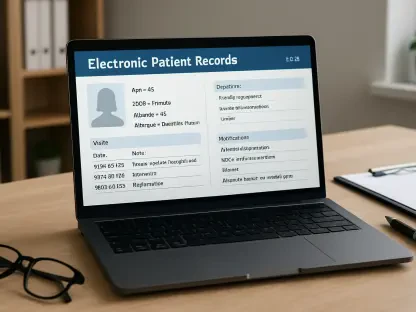Across the healthcare landscape, organizations constantly grapple with optimizing their IT spending to deliver cost-effective services without compromising patient care quality. This ongoing challenge is influenced by various complex factors, including stringent regulatory compliance, efficient data management, and prudent financial oversight. As healthcare providers seek to balance operational costs with enhanced care delivery, strategic IT financial management emerges as a cornerstone. Healthcare entities strive to harmonize technology expenditures with the overarching goal of streamlining processes while safeguarding patient data and adhering to strict regulations. Technological advancements offer promising solutions but also necessitate careful planning and analysis to fully capitalize on their potential benefits.
Navigating Financial Management in Healthcare IT
Effective financial management in healthcare IT becomes increasingly important as providers face persistent upward pressure on costs. This pressure stems from diverse sources, including government regulations, workforce shortages, and escalating operational expenses. As such, the role of IT financial management within healthcare settings is pivotal. By carefully orchestrating IT investments, healthcare organizations aim to mitigate financial risks while bolstering patient care quality. Central to this approach is the deployment of various key metrics that shed light on efficiency. Metrics such as cost per patient visit, revenue percentage attributed to IT spending, and IT downtime costs offer critical insight into the optimization of technology usage, helping to identify areas requiring improvement.
One of the significant challenges is understanding how IT investments align with revenue generation and expense reduction. By analyzing the cost-effectiveness of Electronic Health Records (EHR) systems and telehealth innovations, healthcare providers can guide their IT expenditures more strategically. Furthermore, addressing compliance and security costs becomes essential, given the rising threat of cyber breaches. Robust encryption measures, access control systems, and constant vigilance in data breach detection reinforce patient data security while keeping potential financial losses at bay. The successful application of IT financial management tools enables providers to navigate financial complexities with confidence, ensuring resources are allocated efficiently and effectively.
Ensuring Regulatory Compliance Through Advanced Technologies
Maintaining compliance with regulations like HIPAA and HITECH is non-negotiable for healthcare providers seeking to safeguard patient information and avoid costly penalties. These legal standards necessitate comprehensive strategies for data protection, encompassing not only encryption protocols but also nuanced access controls and continuous monitoring systems. The integration of Electronic Health Records (EHR) significantly aids compliance efforts by facilitating secure data storage and retrieval processes. Constant innovation in healthcare IT paves the way to elevate data security practices that align with evolving regulatory demands.
Efforts to ensure regulatory compliance are complemented by the adoption of sophisticated breach detection systems. These technologies swiftly identify unauthorized data access or potential threats, allowing for immediate remediation actions to prevent breaches and minimize impact. Healthcare providers are embracing compliance-centric IT strategies that involve periodic audits and testing to measure system effectiveness. Investing in training programs for staff ensures that everyone within the organization is aware of best practices, further fortifying the healthcare facility’s data infrastructure against breaches. Implementing these systems requires dedication but proves invaluable in maintaining patient trust and avoiding financial repercussions linked to non-compliance.
Leveraging IT Metrics for Enhanced Efficiency
Utilizing IT metrics represents a strategic approach to refining healthcare operations by pinpointing inefficiencies and deploying corrective measures to optimize resources and processes. These metrics enable healthcare providers to critically analyze operational data, including patient stay durations and incident rates, to identify trends and areas needing improvement. By benchmarking practices against identified standards, organizations can track progress, measure success, and make informed decisions that drive efficient care delivery and operational stability.
Metrics that quantify the cost-effectiveness of technology investments provide invaluable insights into the utility and return on investment of IT initiatives. For instance, examining telehealth investment ROI helps determine whether remote care solutions achieve intended financial outcomes compared to traditional models. Additionally, assessing IT spending as a percentage of revenue enables healthcare providers to gauge their technological endeavors against budgetary constraints while keeping a keen eye on cost per patient visit for refined budget allocation decisions. Healthcare IT professionals prioritize investments that promise sustainable improvements in patient care without straining financial resources, thus reinforcing the strategic deployment of predictive analytics and metrics-driven insights for improving hospital management practices.
Embracing Technological Innovations for Better Care
The adoption of technological innovations paves the way for healthcare providers to transform service delivery by aligning IT spending with superior patient care outcomes. Innovations such as telehealth, wearable devices, and artificial intelligence are revolutionizing healthcare by promising profound economic and clinical benefits. Telehealth, for example, enables remote consultations that reduce the need for physical visits, thereby lowering costs associated with traditional care delivery models. Furthermore, wearable devices and AI-driven predictive diagnostics accelerate early detection of conditions and facilitate proactive health management strategies.
Digital health transformation strategies encompass the integration and utilization of these technologies to achieve resource-efficient healthcare delivery. By aligning budgetary allocations with ventures that offer measurable benefits, providers can tailor their IT spending habits to realize favorable patient experience and operational excellence. The multifaceted advantages of wearable technology also extend to chronic disease management, where consistent monitoring and data analytics contribute significantly to treatment efficacy and patient engagement. With advancing technology and evolving market demands, the healthcare industry remains poised to embrace cost-effective innovations that enhance care quality while maintaining financial stability.
Future Directions in Healthcare IT Optimization
The growing costs in healthcare necessitate effective financial management in IT, as providers confront a mix of challenges like government regulations, workforce shortages, and rising operational expenses. IT financial management is now more crucial than ever in healthcare environments. Skillfully managing IT investments allows healthcare organizations to mitigate financial risks while enhancing the quality of patient care. A strategic approach involves using key metrics to evaluate IT effectiveness. Measures such as the cost per patient visit, the proportion of revenue allocated to IT, and the expenses linked to IT downtime provide essential insights. These insights help optimize technology use, pinpointing where improvements are needed.
A key challenge is understanding how IT investments correlate with generating revenue and reducing expenses. By evaluating the cost-effectiveness of Electronic Health Records (EHR) systems and telehealth technologies, healthcare providers can make strategic IT investment choices. Addressing compliance and security expenses is critical due to increasing cyber threats. Implementing robust encryption, stringent access control, and monitoring for data breaches ensures patient data stays secure, minimizing financial fallout. Using IT financial management tools effectively equips healthcare providers to handle financial intricacies, ensuring resources are used efficiently and wisely.









